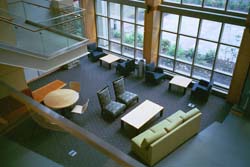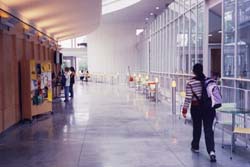|
In the construction trades the act of aligning of building elements is also known as truing, a tacit rectitude. Alignments in social interactions, seeing someone eye-to-eye, may imply agreement, but, more importantly, connote personal relationships. Educational institutions ultimately benefit from strong social ties established by alumni donors while they are students, as George's article this month implies. Arthur's column explores considerations to get the ducks in a row whenever an institution chooses a consultant, the open-eyed truth. We hope you find our perspectives on these topics useful.
If you have reactions or ideas to share, please let us know what you think by e-mailing: editor@dlmplanners.com | |||||
| A Rationale for Campus Life Improvements |
|||||||||||||
Interestingly, it seems that the most successful of these institutions recognize that programs that are delivered only remotely do not provide optimal outcomes. As described by the leaders of two of the best-known cyber-providers at different SCUP plenary sessions over the years, these institutions complement their on-line offerings with place-based activities that facilitate face-to-face interaction of students and faculty 2. Listening to these sessions supports the notion that there is a real human need for personal, physical, eye-contact interchange to truly support learning. Place-based institutions have always recognized this and have increasingly realized that the richer the campus life experience is, the more complete the interaction is, the more compelling the experience can be, and the more profound the possibilities for learning. Institutions that are heavily residential are the classic examples of the type. With a “captive” population, these institutions have the opportunity, indeed, the responsibility, to create a distinctive community and a range of experiences that the student perceives as wholly unique. The intensity of life in such a community can be, by turns, exhilarating and exhausting, but, most importantly, all consuming. People have a fondness for their college years largely in response to these dynamics, which are (some would say thankfully) not readily replicable in later life. Place-based institutions must pay attention to the campus life experience they provide. Increasingly, this factor distinguishes them in higher education. On-line institutions can provide the content, delivering it with ever-improving effectiveness through always-advancing technology. They can provide equivalent content for fewer dollars than place-based institutions. What they cannot provide is the rich, all-consuming campus life experience that enhances and stimulates learning. Creating a dynamic, challenging curriculum conceived and taught by committed faculty in an environment that uniquely supports learning is the obligation and privilege of place-based institutions. The richer the experience, the more profoundly influenced students are and the more tightly bound they become, committing themselves to supporting the institution that afforded them such a thrilling, all-absorbing time in their life. If the mission-oriented rationale needs help, this financial reality helps provides it. Clearly many, if not most, institutions understand this. After all, the range of campus life facilities and opportunities on most campuses is impressive and represents a major investment. For smaller institutions of modest means, however, there is still progress to be made. Academic and residential facilities will always be predominant in mission-driven institutions, but campus life facilities and programs are the essential third leg of the stool that solidly supports learning and living at our campuses.
1 Distance Education at Degree-Granting Postsecondary Institutions: 2000–2001, NCES 2003-17, E.D. Tabs. 2 Diana Laurillard, Pro-Vice Chancellor (Learning Technologies and Teaching) at the Open University in the United Kingdom, SCUP 34 - Atlanta 1999, and Laura Palmer Noone of The University of Phoenix, SCUP 36 - Boston, 2001 |
|||||||||||||
| News | ||||||
Wayne State University - PKAL National Colloquium |
SCUP's Integrated For more information, visit www.scup.org |
|||||
| © Copyright 2005 DOBER LIDSKY MATHEY Creating Campus Solutions |
||||||||
464 Common St., Suite 336
|
||||||||





